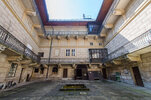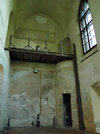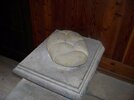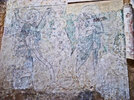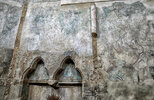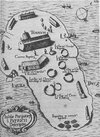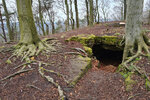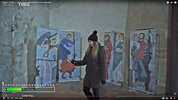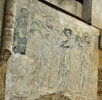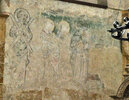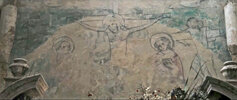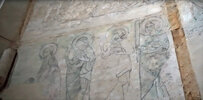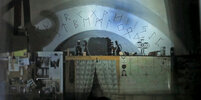Benjamin
The Living Force
I came across this post featuring video's from the Bedtime Stories YT channel. There's some creepy in there. In the mood for more, I watched a few that piqued my interest, and at the end of one of them, Houska Castle was mentioned.
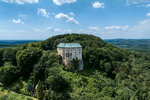
 Tomáš Tuček
Tomáš Tuček
Houska Castle (c. 13th century, about 47 miles north of Prague, Czech Republic) has an interesting tale attached to it. It is said that it was built on top of a crevice or pit that is a ‘gateway to hell’. This was done to prevent the demons from continuing to come out of it.
The folklore of this castle is widely repeated. What I've been able to assemble comes mostly from videos about it, and the ‘solid’ historical info seems to mostly come from (Wenceslas) Vaclav Hajak’s Czech Chronicle from 1541, though it has been discredited as a reliable source since many errors have been apparently found throughout. One of the video's I watched has the current Warden of Houska talking about it's history.
Houska Castle rough Timeline:
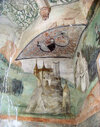
Apparently, a renovation took place at some point, where an over-layer of plaster was removed from the walls of the chapel which exposed the unknown original c. 13th century frescoes beneath. The usual images of the crucifixion, St. Michael and St. Christopher that you would expect to find in a church were found, but the two that really got people’s attention.
See Mapy for lots of good photos (not least of which are a few of the Castle Bezdez seen from Houska), but good images of the two chapel frescoes in question are hard to find.
The first one is a frame lift from the Thinkology video at 3:22. St. Michael thrusts a spear or lance down the throat of a fire-breathing dragon.
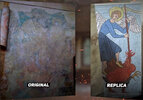
The second is a left-handed, female centaur or chimera, archer. This site described the fresco as the torso of the woman seemingly growing out of the top of a lion's head. She seems to be drawing her bow at the other woman (or man). Much is made of the 'pagan image' as well as the left-hand being associated with the devil, which feeds the 'portal to hell' idea. This is, apparently, the only fresco of this composition found in a chapel anywhere.
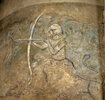
If I zoom out to a broader view, I run into the mountain Blanik. Located about 32 miles southeast of Prague, Blanik holds a well known folklore tale of an army of knights that sleep under the mountain to awake when 'Bohemia' is in its greatest need. It is said that being a day under the mountain is equivalent to a year on the surface, which ties in with the man who journeyed to the underworld and came back an old man. The ‘sleeping army’ is similar to the common folktale of the ‘sleeping king under the mountain’ or 'sleeping hero'.
Also, Wenceslas I, father of Ottakar II, is not to be confused with Wenceslas I (c. 907- 929/35) of Good King Wenceslaus fame who was murdered by his younger brother Boleslaus the Cruel. Drahomira, Good King Wenceslas’ mother, and daughter of a pagan tribal chief of the Havelli, became jealous of the influence Ludmila, Wenceslas’ grandmother, had over her son. Drahomira hired two noblemen, Tunna and Gommon, to murder her mother-in-law, Ludmila, at Tetin Castle. It is said she was strangled with her veil. Now, when I read this, I was almost positive I had read of another woman also being strangled with her veil somewhere. I thought it was in one of Laura’s books but I cannot remember where. Both Wenceslas and Ludmila went on to become saints but I kinda wonder if these two ever existed at all.
I don't know how or why this story became attached to Houska Castle but I get a sense that it is a very mixed tale possibly acting as a cover for something like comets and plagues.

Houska Castle (c. 13th century, about 47 miles north of Prague, Czech Republic) has an interesting tale attached to it. It is said that it was built on top of a crevice or pit that is a ‘gateway to hell’. This was done to prevent the demons from continuing to come out of it.
The folklore of this castle is widely repeated. What I've been able to assemble comes mostly from videos about it, and the ‘solid’ historical info seems to mostly come from (Wenceslas) Vaclav Hajak’s Czech Chronicle from 1541, though it has been discredited as a reliable source since many errors have been apparently found throughout. One of the video's I watched has the current Warden of Houska talking about it's history.
Houska Castle rough Timeline:
- Celts in area c. 8th-12th centuries (evidence referenced from the Bull Rock Cave located northwest of Brno, Moravia, Czech Republic (Býčí skála- where the famous bronze bull of the Hallstatt culture was found along with other evidence tracing back to between 10,000-100,000 BCE.) Official English site and original expanded Czech site.
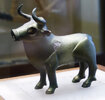
- The area was inhabited by around the 9th century.
- A wooden structure was built here and may have been around for centuries before the castle was built. It might have been a Celtic fort.
- Something significant happened in the year 878 that created a crevice or ‘hole’ in the earth. (This is a strangely specific date that oddly corresponds to the time of habitation in the area.)
- The crevice earned the epithet ‘gateway to hell’, ‘portal to hell’ or ‘gateway to other worlds’. It was mentioned in the chronicles that the rock outcrop (not the castle or building) became inhabited by terrible creatures of many forms (some that were winged) that terrorized people and animals. Pilgrims and travellers no longer wanted to visit the castle.
- The people tried to close the hole by dumping rocks, trash, whatever into it but found it never filled up, leading to the idea that it was a ‘bottomless pit’.
- A prisoner (possibly of the Duda clan (?)) was given the choice of going to jail or being set free if he agreed to first be lowered into the pit by a rope and to report back what he found down there. He agreed, but after a short period of time in the crevice he started to scream and pleaded to be brought back up. Once he emerged, he appeared to have aged 30-ish years and had lost his sanity, dying a few days later. (There are slightly different versions to this story.) Entering the underworld and coming out again sounds like a 'journey to the underworld' tale.
- It is unknown who built it but this early gothic castle- which was later transformed into a chateau- is attributed to c. 13th century (1253-1278) Ottakar II of Bohemia (since he built Castle Bezdez (which you can see from Houska) and several others around the same time (1260-1280), but his father, 'One Eye' Wenceslas I (1230-1253), is also a good candidate. The Romanesque-gothic chapel of St. Michael was built first and, apparently, right on top of the hole sealing the breach.
- Much later, it was occupied by the Nazis in WWII. Occult experiments are said to have occurred here (of course).
- Throughout its history, there is apparently evidence that Houska sat empty for long periods of time to the tune of years or decades possibly.
- Around 2013/14, a room was found at the level of the original foundation. It may have been a cistern for rainwater or storage for grain.
- No known inhabited territory (looking at paintings on the walls suggest that there were villages nearby. I think this idea is busted.)
- No known trade route nearby
- Not near a known border
- Apparent militarily insignificant location (I don't know about this one. Bezdez, another smallish castle, was built fairly close to Houska.)
- Built in a forest on the edge of a cliff (which provides great views and makes it easier to defend)
- The forest is said to be poor for hunting (though there are paintings of deer, foxes, horses, rabbits and a bear attack, and a current report posted on Trip Advisor mentioning an ‘infestation’ of grey rabbits in the area. This idea is busted.)
- Apparently built ‘inside-out’: defences (that have since been removed) were facing the stone courtyard at the centre of the building instead of around the exterior which suggests the castle is meant to keep people (or whatever evil thing comes out of the crevice) in, rather than out, of the castle. In a way, like a prison.
- No kitchen (part of castle no longer there?)
- No water source (It was mentioned in the Researchers video that during WWII, children were kept in a room with a well, but this room has since not been found.)
- No rudimentary sewer system (part of castle no longer there?)
- Several outer windows are cosmetic having being sealed with rock on the inside (meh)
- No outer wall (If you look closely at the original painting, you can see the outline of a wall (crenels). Besides, you don't need much of a wall when it's built on a cliff. Busted.)

Apparently, a renovation took place at some point, where an over-layer of plaster was removed from the walls of the chapel which exposed the unknown original c. 13th century frescoes beneath. The usual images of the crucifixion, St. Michael and St. Christopher that you would expect to find in a church were found, but the two that really got people’s attention.
See Mapy for lots of good photos (not least of which are a few of the Castle Bezdez seen from Houska), but good images of the two chapel frescoes in question are hard to find.
The first one is a frame lift from the Thinkology video at 3:22. St. Michael thrusts a spear or lance down the throat of a fire-breathing dragon.

The second is a left-handed, female centaur or chimera, archer. This site described the fresco as the torso of the woman seemingly growing out of the top of a lion's head. She seems to be drawing her bow at the other woman (or man). Much is made of the 'pagan image' as well as the left-hand being associated with the devil, which feeds the 'portal to hell' idea. This is, apparently, the only fresco of this composition found in a chapel anywhere.

If I zoom out to a broader view, I run into the mountain Blanik. Located about 32 miles southeast of Prague, Blanik holds a well known folklore tale of an army of knights that sleep under the mountain to awake when 'Bohemia' is in its greatest need. It is said that being a day under the mountain is equivalent to a year on the surface, which ties in with the man who journeyed to the underworld and came back an old man. The ‘sleeping army’ is similar to the common folktale of the ‘sleeping king under the mountain’ or 'sleeping hero'.
Also, Wenceslas I, father of Ottakar II, is not to be confused with Wenceslas I (c. 907- 929/35) of Good King Wenceslaus fame who was murdered by his younger brother Boleslaus the Cruel. Drahomira, Good King Wenceslas’ mother, and daughter of a pagan tribal chief of the Havelli, became jealous of the influence Ludmila, Wenceslas’ grandmother, had over her son. Drahomira hired two noblemen, Tunna and Gommon, to murder her mother-in-law, Ludmila, at Tetin Castle. It is said she was strangled with her veil. Now, when I read this, I was almost positive I had read of another woman also being strangled with her veil somewhere. I thought it was in one of Laura’s books but I cannot remember where. Both Wenceslas and Ludmila went on to become saints but I kinda wonder if these two ever existed at all.
I don't know how or why this story became attached to Houska Castle but I get a sense that it is a very mixed tale possibly acting as a cover for something like comets and plagues.

 Unfortunately it looks like the place is only open from April to October. (
Unfortunately it looks like the place is only open from April to October. (